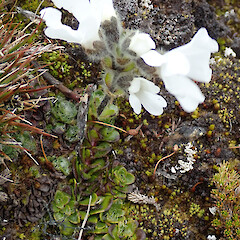Ourisia glandulosa
Common name
mountain foxglove
Synonyms
None
Family
Plantaginaceae
Flora category
Vascular – Native
Endemic taxon
Yes
Endemic genus
No
Endemic family
No
Structural class
Herbs - Dicotyledons other than Composites
NVS code
The National Vegetation Survey (NVS) Databank is a physical archive and electronic databank containing records of over 94,000 vegetation survey plots - including data from over 19,000 permanent plots. NVS maintains a standard set of species code abbreviations that correspond to standard scientific plant names from the Ngä Tipu o Aotearoa - New Zealand Plants database.
OURGLA
Chromosome number
2n = 48
Current conservation status
The conservation status of all known New Zealand vascular plant taxa at the rank of species and below were reassessed in 2017 using the New Zealand Threat Classification System (NZTCS) – more information about this can be found on the NZTCS website. This report includes a statistical summary and brief notes on changes since 2012 and replaces all previous NZTCS lists for vascular plants.
Please note, threat classifications are often suggested by authors when publications fall between NZTCS assessment periods – an interim threat classification status has not been assessed by the NZTCS panel.
- Conservation status of New Zealand indigenous vascular plants, 2017 . 2018. Peter J. de Lange, Jeremy R. Rolfe, John W. Barkla, Shannel P. Courtney, Paul D. Champion, Leon R. Perrie, Sarah M. Beadel, Kerry A. Ford, Ilse Breitwieser, Ines Schönberger, Rowan Hindmarsh-Walls, Peter B. Heenan and Kate Ladley. Department of Conservation. Source: NZTCS and licensed by DOC for reuse under the Creative Commons Attribution 4.0 International licence.
2017 | Not Threatened
Previous conservation statuses
2012 | Not Threatened
2009 | Not Threatened
2004 | Not Threatened
Habitat
Alpine (1,050-2,000 m a.s.l.) in damp, south-facing, shaded sites within tussock-land, herbfields, and scrub. Usually amongst rocks, in crevices or stonefields.
Detailed description
Perennial herb 5-135 mm tall, with erect inflorescence and repent leaves; stems 1.3-2.8 mm diameter, internodes 1.3-7.1 mm long, clearly separated, glabrous. Leaves opposite, distichous, densely packed along creeping stems; petiole 1.8-5.0 x 1.1-3.8 mm, glabrous or eglandular pilose mostly along margins; lamina 4.7-10.6 x 3.0-8.4 mm, narrowly to broadly obovate, spathulate, apex rounded, base attenuate, margin subentire or with 1-few, irregular notches or regularly crenate, upper surface, punctate, sparsely or densely eglandular pilose near apex, undersides glabrous, punctate. Inflorescence racemose, 1-7-flowered, 48-143 mm long, bracteate, with 1-4 flowering nodes, 2 bracts and 1-2- flowers per node; peduncle 0.8-1.5 mm diameter, pilose or villous, densely glandular/eglandular hairy. Floral bracts up to 6.0-9.1 x 3.6-8.0 mm, sessile or with short, wide petioles, narrowly to broadly obovate, margins subentire or 1-few notched, often emarginate, glandular/eglandular pilose or villous. Flowers 13.5-18.8 x 6.8-15.9 mm; pedicel 5.8-21.9 mm long, pilose to villous, hairs mostly glandular. Calyx 6.2-8.6 x 4.0-8.3 mm, irregular, externally eglandular/glandular pilose, internally mostly glabrous, anterior calyx lobes 5.2-7.1 x 1.5-3.6 mm, posterior calyx lobes 1.3-3.1 x 1.5-3.2 mm, 3 posterior lobes divided 1/4 of calyx length, 2 anterior lobes divided to near base, lanceolate, or narrowly ovate, rarely oblanceolate to narrowly obovate, apex rounded, rarely subacute, prominently 3-veined below. Corolla 14.5-19.0 x 21.1-23.0 mm when flattened, bilabiate, tubular-funnelform, straight or slightly curved, white, externally glabrous; tube 6.1-9.8 x 4.3-5.9 mm at apex, 2.1-3.5 mm wide at base, not constricted near base, mostly yellow inside, sometimes purple outside near base only, glabrous; anterior corolla lobes 7.2-10.3 x 5.1-6.6 at widest point, 2.2-3.1 mm wide at base, posterior corolla lobes 5.0-8.0 x 4.4-7.0 mm wide at widest point, 1.9-3.3 mm wide at base, spreading, obovate or slightly obcordate, apically plane, slightly emarginate or undulate. Stamens 4, didynamous; comprising two long stamens 5.9-10.0 mm long, reaching tube opening, and two short stamens 3.7-8.9 mm long, included; anthers 0.7-1.2 x 0.8-1.1 mm, reniform to horseshoe-shaped; staminode c.0.2-1.7 mm long, inserted c.0.2-0.7 mm above base of corolla, or absent. Style 4.0-6.0 mm long, slightly curved, not exserted; stigma 0.4-0.8 mm diameter, emarginate; ovary 2.9-4.8 x 1.1-2.3 mm, glabrous. Capsules 5.5-6.0 x 4.3-4.6 mm, glabrous, dehiscence loculicidal, rarely septicidal. Seeds 0.6-1.0 x 0.4-0.6 mm.
Similar taxa
Distinguished by the small stature and numerous, short glandular hairs on most parts of the plant except the leaves.
Flowering
December - March
Flower colours
White, Yellow
Fruiting
January- April
Propagation technique
Difficult - should not be removed from the wild.
Etymology
ourisia: After Ouris, governor of the Falkland Islands
glandulosa: Gland bearing
Where To Buy
Not commercially available
Attribution
Description based on Meudt (2006).
References and further reading
Meudt, H.M. 2006: Monograph of Ourisia (Plantaginaceae). Systematic Botany Monographs 77. 188 pp.










